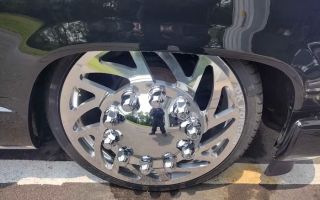- 1 - Why Winter Affects Car Batteries
- 2 - Preparing Your Battery for Storage
- 3 - Proper Storage Locations and Conditions
- 4 - How to Maintain Battery Charge During Storage
- 5 - Common Mistakes to Avoid in Cold Weather
- 6 - Real-World Example: A Costly Battery Failure Story
- 7 - Professional Help from Rescue & Towing
1. Why Winter Affects Car Batteries
Cold weather is one of the toughest challenges your car battery can face. When temperatures drop, the chemical reactions inside a battery slow down, reducing its ability to hold a charge. A fully charged battery at 80°F can lose nearly half its power at 0°F. At the same time, engines require more energy to start in freezing conditions due to thicker oil and increased internal friction. This combination makes winter the prime season for battery failure.
For anyone storing a vehicle over the winter—whether a classic car, RV, or even a backup vehicle—it’s essential to understand the best practices for car battery storage in winter. Without proper preparation, you could return in spring to find a dead battery or, worse, irreversible internal damage caused by freezing electrolytes.

Pick Your Part - Help Yourself
1232 Blinn Ave, Wilmington, CA 90744, USA
2. Preparing Your Battery for Storage
Before you store your vehicle, it’s critical to prepare the battery correctly. Start by fully charging it, as a fully charged battery is much less likely to freeze. Use a digital voltmeter to ensure the voltage reads at least 12.6 volts. If it’s lower, recharge it before storage.
Next, clean the terminals thoroughly to remove any corrosion. A simple mixture of baking soda and water works wonders. Once clean, dry the terminals completely and apply a thin coat of petroleum jelly or dielectric grease to prevent future corrosion. Finally, disconnect the battery cables—starting with the negative terminal—to prevent any parasitic drain from your car’s electronics.
If you plan to store your battery separately, label the cables to make reconnection easier later. These small steps can save you significant headaches and expenses once the cold season passes.

Pick Your Part - Greer
13054 E Wade Hampton Blvd, Greer, SC 29651, USA
3. Proper Storage Locations and Conditions
The location you choose for battery storage during winter can make or break its lifespan. Avoid storing the battery in an unheated garage or shed where temperatures can drop below freezing. Instead, opt for a cool, dry indoor environment such as a basement or utility room. Ideally, the temperature should remain between 40°F and 60°F.
Store the battery upright on a clean, flat surface—never on concrete floors, as prolonged contact can cause temperature-related discharge. It’s also wise to use a battery box or tray to contain any possible leaks. While modern batteries rarely leak, it’s always better to be safe, especially when stored indoors.
Some car enthusiasts go a step further by using a breathable battery cover. This helps regulate temperature and humidity, preventing condensation buildup that could lead to corrosion over time.
4. How to Maintain Battery Charge During Storage
Even in storage, your car battery will gradually lose charge—a process known as self-discharge. To prevent this, use a battery maintainer or trickle charger. Unlike standard chargers, maintainers automatically regulate voltage, ensuring the battery remains at a safe and steady charge level without overcharging.
Connect the maintainer once the battery is removed from the vehicle, or directly to the battery terminals if it remains installed. For longer storage periods (over three months), check the battery every four to six weeks with a voltmeter. If the voltage drops below 12.4 volts, recharge it immediately.
Owners who skip this step often find themselves with a sulfated battery—where lead sulfate crystals form on the plates—making recharging difficult or impossible. Investing in a quality maintainer is far cheaper than replacing a dead battery in spring.
5. Common Mistakes to Avoid in Cold Weather
Many drivers unintentionally shorten their battery’s lifespan by making preventable mistakes during winter. Here are a few to watch for:
1. Leaving electronics plugged in: Even minor power draws, like phone chargers, can slowly drain the battery during storage.
2. Storing a partially charged battery: Low charge increases the risk of freezing and sulfation, both of which permanently damage internal cells.
3. Neglecting to clean terminals: Corrosion buildup can reduce electrical contact, weakening performance once the battery is reinstalled.
4. Ignoring inspection intervals: Batteries that sit unattended for months often develop undetected issues that could have been prevented with regular checks.
Taking proactive care ensures that your vehicle’s power source remains strong, reliable, and ready to start even after months of inactivity.
6. Real-World Example: A Costly Battery Failure Story
One winter in Minnesota, a truck owner named Daniel decided to store his vehicle outdoors for three months without disconnecting the battery. Temperatures frequently dipped below zero, and by February, his battery case had cracked due to freezing. When he tried to start the vehicle in spring, the battery was completely dead and leaking acid—causing over $800 in corrosion-related damage to the engine compartment.
Daniel later learned that simply removing the battery and storing it indoors could have prevented the entire situation. His experience serves as a valuable reminder that proper winter storage isn’t just about convenience—it’s about protecting your investment.
7. Professional Help from Rescue & Towing
For car owners unsure how to prepare their batteries for cold storage, professional guidance can make all the difference. Rescue & Towing offers expert vehicle maintenance and winter readiness services, ensuring that your car remains in top condition throughout the coldest months.
Whether you need a battery inspection, jump-start assistance, or advice on the best battery storage methods, their experienced team can help you avoid costly mistakes and keep your vehicle road-ready. With professional support and proper care, your battery can easily survive even the harshest winter conditions.
So, before the next freeze sets in, take time to follow the best practices for car battery storage in winter—your vehicle (and your wallet) will thank you when spring arrives.




























